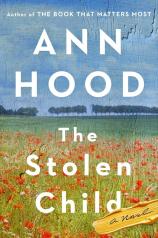Reading Group Guide
Discussion Questions
The Stolen Child

1. What do you make of the title THE STOLEN CHILD? Is there only one “stolen child” in the novel, or could multiple characters fit that description? After finishing the novel, how do you read the epigraph from the poem of the same title?
2. The novel mainly alternates between Nick’s, Jenny’s and Enzo’s perspectives. How did you connect to the different characters? What qualities do they all share? Why do you think Ann Hood chose to structure the story with different timelines and perspectives?
3. When Jenny first sees the Brown students in formal wear discussing Nick’s ad, Hood writes, “She tried to picture that life, but came up blank. That was her problem: she couldn’t picture a life for herself” (60). In what ways is this true for Jenny at the outset of the novel? How does she view herself in comparison to the students she waits on? In comparison to Vera?
4. Camille and Jenny both gave up their babies, though under very different circumstances. How much had changed for women between Camille’s decision in 1917 and Jenny’s in 1972? How might they have made different choices today? How does Camille’s story help Jenny come to terms with her own?
5. Enzo collects tears from famous and ordinary people, from strangers and those closest to him. Whose tears moved you? Why do you think Enzo is so attuned to these emotions? How do his labels elevate the vials of tears?
6. Consider the character Everleigh Greer. Why do you think Nick opens up to her? What role does she play in the novel? What does her path --- proudly divorced and painting in France --- represent?
7. In what ways do Jenny’s relationships with Russ, Charlie and Daniel differ? What does her romance with Daniel have that the others don’t?
8. When Nick doesn’t receive a reply to his letter to Camille in 1944, he figures she hadn’t received it. “Because surely, if she had, she would have answered him. Surely she was, just like him, tortured by what had happened, by what had become of her Laurent” (85). Do you think Camille would have replied if she had received Nick’s letter? How do you think her decision affected her? How might the story have played out if Camille had lived?
9. In the village where Nick left Laurent, the story has been passed down in various versions --- including that the baby was an angel sent to protect the village from “seeing war and/or shedding tears” (133). What do you make of this story? What does it say about the aftermath of the war?
10. While most of the novel is told through the three main characters, later in the novel Hood follows Geraldine Walsh. How does Geraldine’s perspective compare to Enzo’s on their love story? How does her story fit into the rest of the novel?
11. From buying a suit with her mother in preparation for the trip to donning the earrings Nick gives her in Naples, Jenny’s style shifts through the novel. What do her clothes say about her?
12. When Jenny tells Nick that she wants to take over the Museum of Tears, she says, “But the tears aren’t really the point, are they? It’s more the recording, the witnessing, of human sorrow” (235). Why do you think she connects with it so deeply? What gives the Museum of Tears its power? Would you visit such a museum?
13. Jenny tells Aria that the museum is Enzo’s “greatest work of art” (267). What role does art play in the novel? What relationship do all the artists in the novel --- Enzo, Camille, Massimo, Everleigh, Aria and even Nick --- have to their art?
14. Were you surprised by Enzo’s identity? Why do you think his mother made Jenny, Nick and Charlie leave? How does the conclusion of the mystery of the stolen child meet and subvert your expectations?
15. When Jenny learns about Enzo’s identity and the letter from Camille, she thinks, “How different Nick’s life would have been if he’d known that Camille gave up her baby willingly!” (277). How do you think Nick’s life would have been different? Do you think he still would have felt he made the wrong decision?
16. How does the revelation that Nick kept Camille’s paintings change your perspective on his decision to leave Laurent? Why do you think Jenny decides to keep them? What would you do in Nick’s shoes? In Jenny’s?
17. What message does this novel send about regret and forgiveness? Do you think the characters forgave themselves? Why or why not?
The Stolen Child
- Publication Date: May 6, 2025
- Genres: Fiction, Historical Fiction, Women's Fiction
- Paperback: 320 pages
- Publisher: W. W. Norton & Company
- ISBN-10: 1324110392
- ISBN-13: 9781324110392







